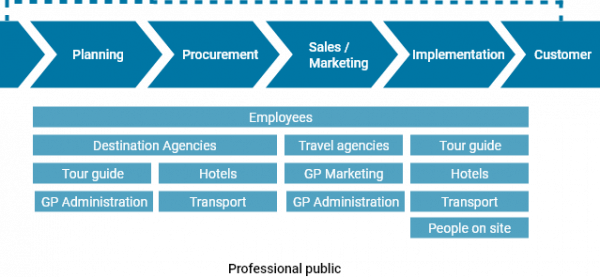Corporate Responsibility step by step
DETERMINING TOPICS FOR YOUR OWN COMPANY
Large companies employ entire CR departments – in medium-sized companies, the solutions should be pragmatic and implementation-oriented.
Not all corporate responsibility topics are equally relevant for every company. For many SMEs, it is neither practicable nor sensible to deal with all topics in detail or even to implement measures on every topic. Therefore, they should set priorities and devote themselves primarily to their essential topics.
A CR strategy shows the way to clearly defined CR goals. The selection of topics should be based on a materiality analysis and fit the core business. In addition, a CR strategy should define the company’s aspirations and establish responsibilities within the company.
The CR Compass offers the possibility to create a materiality matrix with your individual topics in the portal. In this form of presentation, topics are classified according to their importance for the company and important stakeholders. Important CR topics become apparent and form a starting point for both strategic planning of activities and reporting.
When deciding whether an issue is material, both internal and external factors should be considered, e.g.
- The company’s value chain
- Opportunities and risks arising from the value chain for people, the environment or society
- Stakeholder concerns
- Internationally recognised standards such as the Ten Principles of the Global Compact
DEALING WITH STAKEHOLDERS
Addressing stakeholders
Stakeholders are those persons or groups that influence the activities of a company or can be influenced by the company. These include employees, customers or suppliers, but in a broader sense also neighbours, political organisations, the public or the environment. These stakeholders often have a very different perception of your company from their perspective – and this too has its right to exist. To carry out meaningful CR activities, you should take these perceptions seriously and engage with them.
Often there is a great opportunity in this, because stakeholders can help determine relevant issues through their different perspectives.
Who are the stakeholders?
Example - Stakeholder identification
The following example from Studiosus is an excerpt from the web-based sustainability report.
Studiosus’ business of planning, operating and marketing study tours brings the company into contact with many different interest groups (stakeholders). Stakeholders were identified on the basis of the value chain of a Studiosus tour, as shown in the following diagram.

Internally, departments or areas such as planning, purchasing, sales, marketing and implementation are involved in the creation of study tours. Many other departments, such as administration and human resources, complete the process. At the end of the value chain is the customer who consumes the service – the trip.
The most important group of stakeholders are the clients, whom Studiosus regards as partners. A good relationship with them and their satisfaction with the tours, are an indispensable prerequisite for securing the company’s existence.
Equally important are the employees who are involved in the entire value-added process in the creation of the study tours. Only with qualified and motivated staff can the high expectations of clients placed on a Studiosus tour be met.
Studiosus’ business partners include hotels, incoming agencies, transport companies and travel agents. At the local level, business partners (BPs) in marketing and administration are also included. Good cooperation with them is essential to achieve the company’s goals.
Studiosus’ stakeholders also include the people in the destinations. Studiosus is aware that tourism can create problems. Studiosus therefore seeks to take account of the interests of the local population, their independence and their desire for self-determination, and to respect local customs and cultural idiosyncrasies.
Finally, the stakeholders are complemented by the professional public. These include trade associations, tourist boards, tour operators, governmental and non-governmental organisations, tourist media and the press.

IMPLEMENTING CR IN SMALL AND MEDIUM-SIZED ENTERPRISES
A successful CR strategy often requires more than selecting appropriate topics and considering relevant stakeholders. True success requires a systematic plan and clear responsibilities. Cooperation and partnerships are also a great advantage and enable successful implementation.
> Management and implementation
The implementation of corporate responsibility should be managed systematically to ensure that the defined CR goals are achieved. To this end, it is important to plan and implement guidelines, processes and measures that are aligned with the goal. The application of management systems can support this.
Clean project planning and clear responsibilities help to ensure implementation.
> Cooperation and networks
It is of great importance for SMEs to realise their CR strategy with the help of different cooperations. This can be, for example, a strategic partnership with one or more companies that pursue similar CR goals.
For example, financing a company day-care centre (KITA) to improve the compatibility of family and work is usually only feasible for SMEs in a network.
Often partnerships also offer new opportunities by combining different competences. For example, cooperation with regional environmental experts can help optimise the CO2 or water footprint and thereby reduce costs.
Furthermore, for many SMEs, membership or participation in networks such as the United Nations Global Compact also makes sense in order to exchange experiences and build up knowledge.
Practical example - Management
The following example is an excerpt from the 2011 Sustainability Report of Neumarkter Lammsbräu.
The use of management systems to control a company is often “frowned upon” by small and medium-sized enterprises. Many of these companies are of the opinion that the application of management systems is too bureaucratic and time-consuming.
Possible costs incurred in this context are seen as superfluous or grudgingly as a necessary evil, for example in the case of companies whose customers demand proof of a certain management system as a prerequisite for delivery. Other companies – including many companies in the organic sector – believe that it is sufficient if the company somehow “lives” the philosophy associated with the company’s purpose. Many of these companies are therefore rather “gut-driven” in this respect and run the risk of being reduced to the entrepreneurial skill and conviction of individual persons – the company leader(s) – in case of emergency.
Neumarkter Lammsbräu understands the application of management guidelines as an aid through which we can further develop our company, communicate the entrepreneurial vision internally and distribute the management tasks over several shoulders. In doing so, we attach great importance to the fact that we do not make ourselves the “slave” of a certain management guide, but that we adapt the system to our operational conditions. One of the benefits of the management guidelines for our company is that we can better focus on issues such as improving our operational environmental performance or customer-oriented actions.
In addition, it is in the nature of management systems that gentle pressure is repeatedly exerted on the company and thus also uncomfortable issues, which tend to be relegated to the background in day-to-day operations, are addressed and taken into account in decision-making.
For many years, the EFQM model has served us as an overarching management system bracket, with the help of which we have been able to map and improve our entire company, starting with the strategy and management, through the work processes and the people who work in and with Neumarkter Lammsbräu, to the manifest results of our actions. In doing so, we attach great importance to integrating aspects of sustainability in all areas of our company.
We handle ecological improvements, customer-related aspects and occupational safety issues with the help of an integrated management system, which in turn consists of individual, “classic”, certifiable management guidelines, such as environmental management in accordance with the European EMAS regulation and the quality management standard, DIN ISO 9001.
What all these management guidelines have in common is that they can only be maintained if operational activities are documented and, above all, communicated, from their planning and objectives, through their implementation, to their evaluation. Documentation “reminds” us again and again of our resolutions and enables us to track and evaluate the resulting measures. In order to bring management guidelines to life, they must be integrated into the respective corporate strategy and the derived measures must be actively communicated within the company.
How does this work at Neumarkter Lammsbräu? Neumarkter Lammsbräu develops its strategies on the basis of long-term and medium-term strategic planning.
Read on in the report!
Neumarkter Lammsbräu, Sustainability Report 2011, p. 18